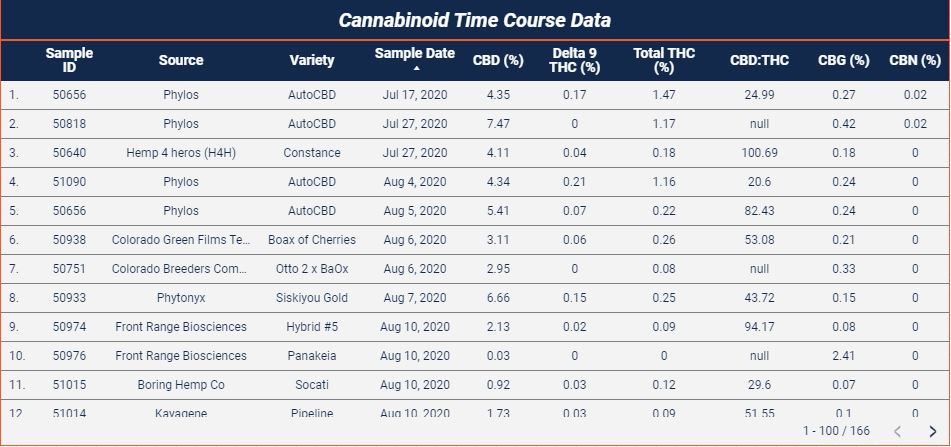Midwestern Hemp Database: A New Tool for Hemp Growers
A “new” crop to Midwestern agriculture, best management practices (BMPs) and varietal performance of industrial hemp have yet to be determined. Hemp producers are required to grow hemp that contains less than 0.3% tetrahydrocannabinol (THC) to comply with state and federal regulations. Failing to do so will result in crop destruction and potentially significant financial losses. There is a lack of university published resources regarding “THC compliant” varieties which produce adequate amounts of cannabinoids, such as cannabidiol (CBD), cannabigerol (CBG), and cannabinol (CBN). As a result, most of the available information comes from private parties and is often lacking cited references or proper scientific methodology. Further, with the impending adoption of USDA rules this will be a valuable year to gain information regarding variety performance of industrial hemp.
What is the Midwestern Hemp Database?
In response to this knowledge gap, the Midwestern Hemp Database was developed. The Midwestern Hemp Database is a collaboration between land grant institutions, private laboratories, and grower cooperators across the region. The goal of this project is to provide regional insight into agronomic performance and cannabinoid development of industrial hemp varieties. This information can be accessed in a publicly available, interactive display. There are plans to expand the scope and focus of this database moving forward.
Participation in this program provides growers an exciting opportunity to receive discounted cannabinoid profiling in exchange for information on their production systems and agronomic performance. Participating grower-cooperators must follow specific instructions regarding floral sampling and shipping in order to retain the integrity of the experiment. Any identifying personal information is kept confidential and will not be made available to the public. This project relies heavily on grower data collection and sampling throughout flowering. In the first year of the program, over 140 growers across the Midwest (Illinois, Wisconsin, Indiana, and Michigan) were enrolled into the program, representing 440 variety entries. Throughout the remainder of the growing season graphs and figures will be updated with results as they become available. The interface is a work in progress, so please be patient as we work out the kinks for improved functionality and customization of the data presented.
Across the region hemp is in full flowering mode with the number of samples being analyzed increasing weekly. Below you will find quick update on some of the data we have collected thus far, with over 160 samples analyzed and entered into the Midwestern Hemp Database. These samples vary in variety, source, and sampling date but this information can be viewed either in the corresponding table or by simply hovering over the data points on the figure. These tests do not replace your required state approved testing, nor are the results recognized by regulatory agencies. Results and interpretations here are for educational purposes only.
September 11th, 2020 Results Summary
- We are now nearing the middle of September and harvest will be here before we know it for most of the full-season varieties in the region (typically end of September/October). Now is the time to consider taking steps for harvest (notifying the appropriate regulatory agency, sending in samples through your state approved laboratories prior to harvest etc.). As always, be caught up on the rules and regulations for growing compliant hemp in your state as they are quite different from each other.
- There are some early-flowering and auto-flowering varieties entered into the database which have different planting and harvesting schedules than typical full season varieties. This may explain why some of the cannabinoid values are significantly greater, or appear as potential outliers. Hovering over the data points will reveal varietal and sampling information.
- Be aware of the difference between Delta-9-THC and Total THC and how state and federal programs define compliance. This is a subtle, but important distinction and will have impacts on end product use, potential for interstate commerce, and utilization of certain distribution channels.
- In Figure 1, a significant number of samples are approaching or exceeding the regulatory limit of .3% Total THC for industrial hemp, which is indicated by the horizontal red line. What is of concern is that samples above that red line would be considered non-compliant if these were official tests conducted by state or federal regulatory agencies and we are not even half way through September. Until more information is known about variety performance, frequent testing will continue to be encouraged throughout flowering to monitor cannabinoid levels.

Figure 1. Scatter plot showing the relationship between Total CBD (%) and Total THC (%). - While these reports are focusing primarily on THC and CBD, results for other cannabinoids (CBG, CBN, etc.) and Organic CBD Nugs, are available in the Midwestern Hemp Database in the form of an interactive table. This data can be sorted by selected parameters (source, variety, sampling date, etc.) which can help refine search results.

Table 1. Cannabinoid Time Course Data for Variety Submissions
This database is in the early stages still and will contain data pertaining to final cannabinoid accumulation and agronomic performance later this fall. This database is a living document and will be altered as needs and interests change to better serve our stakeholders. If you have any questions, contact University of Illinois Extension Commercial Agriculture Educator, Phillip Alberti at palberti@illinois.edu.





